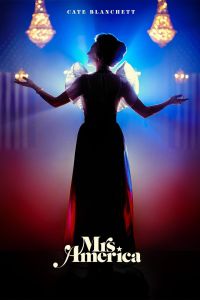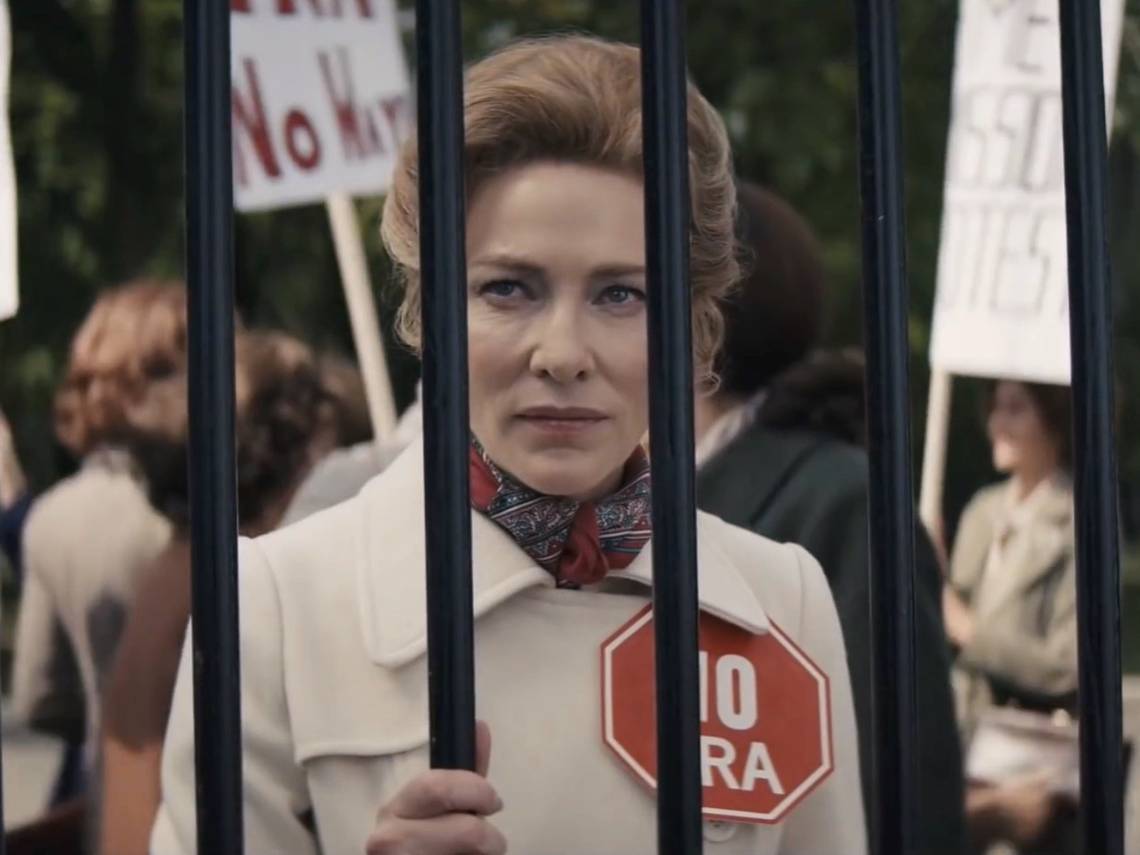Mrs. America Redux
Posted By P. J. Collins On In North American New Right | Comments DisabledOne of the great unexpected pleasures of the Covid lockdown last spring was discovering oddball television series you otherwise wouldn’t have approached with a barge pole. Producers and programming executives detected a nice angle here, so they moved up launch dates by a few months. This is what happened with Mrs. America, a nine-part FX series with Cate Blanchett that debuted on Hulu [2] last April and May, instead of its originally scheduled launch in July and August.
Since its first outing, I’ve gone back to Mrs. America a couple of times. And I’m here to say that it is that rare thing in television docudramas: original, witty, sublimely cast, surprisingly authentic. And also delightfully watchable, something you might not expect in a script about modern politics. At first, I was put in mind of another political drama, 2008’s Recount, the one about the 2000 Presidential election, where Tom Wilkinson as a very convincing James Baker says “Get Me Roger Stone.”
In Mrs. America, we have Cate Blanchett playing Phyllis Schlafly. Cate is taller and older and a bit more regal and willful than the genuine item in the 1970s. But that all works well here, because Cate dominates every scene she’s in, reducing all the other featured players to a minor supporting cast.
In the promotional copy for the series, she’s depicted as a perverse villain, someone who wants to be subservient to men, if such a thing can be imagined: which is why she fights hard to hold back the march of Feminism and the Equal Rights Amendment. (“Cate Blanchett shines as a frigid firebrand,” screamed Salon [4]. Frigid? She had six kids.) But in the actual production, she’s nothing of the kind; she’s a Valkyrie-heroine who’s twice as smart and three times the woman as her mutant-like opponents could hope to be — Bella Abzug, Betty Friedan, Gloria Steinem, Shirley Chisholm, et al.
Up against today’s media and political environment, Mrs. America is so transgressive that I scratched my head in wonder: how in hell did this thing ever get green-lighted in the first place? What was the elevator pitch?
How’s about: “It’s about 1970s politics, as seen through the eyes of Midwestern anti-feminist activist Phyllis Schlafly!”
No, that wouldn’t do at all. Try: “It’s a satire on early 1970s feminism, how Ms. magazine and the Equal Rights Amendment proponents failed, and what inept losers those people were.”
To be sure, that is a pretty accurate description of how the series turned out. The Left-liberal women arrayed against Schlafly all get their own episodes, and these are deft character studies in which they’re usually depicted as troubled, temperamental, and even promiscuous. Negro lesbians and huge rubber dildos figure here and there, however briefly. The message comes across loud and clear: Phyllis Schlafly’s opponents were one helluva degenerate bunch.
But you can bet your boots this wasn’t the elevator pitch. No, Mrs. America was probably sold as what most reviewers expected it to be: a celebration of the Equal Rights Amendment.
Here’s an extract from an early review [5]:
The Equal Rights Amendment was, without a doubt, one of the most critical times in the history of the United States. Every woman should be equal and respected in the same way that men are. Each of us should know the course of such a crucial moment. . .
Schlafly knows how to manipulate men around her, and when she discovers the ERA (Equal Rights Amendment), she strongly opposes its beliefs. She gathers the group of like-minded women . . . and battles against the ratification of the Equal Rights Amendment to the U.S. Constitution.
This is shallow and misleading, but no more so than most descriptions I’ve read. Knows how to manipulate men? Please.
More importantly, Phyllis Schlafly did not originally oppose the ERA. No, she did not. This is a key plot point early in the series. Schlafly was vaguely supportive, regarding the ERA as no more than an anodyne, feel-good initiative. But gradually she came to realize that the body of common and statutory law is shot through with protections for women, and these are there for reasons of biology and social dynamics (i.e., the family).
Today you’d probably have to hunt down a radical-feminist attorney to find someone who can clearly articulate this viewpoint. But most people today, as in Schlafly’s era, are completely impervious to these basic facts. When Schlafly and her supporters talked about how the ERA would mean your daughters can be drafted, the common rebuttal was, “But that won’t happen, because President Nixon just ended the draft!”
Here we hit a level of denseness that shouldn’t even be possible. There’s no draft now, so women won’t be in combat in 40 or 50 years. Scary! There’s just no arguing with it.
The only solution is to pull a Schlafly: mock your opponents for forty years, and show how ridiculous they are.
During the series’ initial release I was puzzled by the fact that most reviewers I read seemed to be watching a very different Mrs. America from the one I was seeing. The obvious explanation was cognitive dissonance. The reviewers were reading advance materials as well as each other’s reviews. As a result, they replicated the same errors. They didn’t see that what they were writing was completely at odds with the series they were reviewing.
A tiny but telling mistake is the claim that the young Mrs. Schlafly attended “Radcliffe University.” I read this in three or four places. Now, I know a building at Oxford called Radcliffe Camera, and I know the old women’s college at Harvard known as Radcliffe College.
But Radcliffe University is unknown to me and also to Google. So it is a wonderment to me how someone literate enough to write a TV review can pull such a boner, thereby announcing to the world that he or she doesn’t critique or research at all — rather, they merely parrot whatever press releases someone sends them.
* * *
I want to go back to the matter of authenticity here, because except for a few fictionalized bits for dramatic flow, Mrs. America captures an era to an extent I’ve never seen before. I can well imagine the writer and directors hanging huge signs on their walls, saying THIS IS 1972 (or whatever), with a laundry list of that year’s culture markers.
The opening titles [7] for Mrs. America are extraordinary, an animated mashup of Peter Max, Yellow Submarine, and the title graphics for Charlie’s Angels. Over the animation, we get the opening bars of Beethoven’s Fifth Symphony. (I kept misremembering this music as coming from a Moog Synthesizer, but that isn’t so, alas; it would be just too, too perfect and early-70s.)
Bits of contemporary news footage are interspersed here and there, with poignant results. Howard K. Smith, the ABC News anchorman, reads out a snippet about the Equal Rights Amendment, with a graphic of the fist-in-Venus-glyph behind him. How weird it seems now that we so matter-of-factly accepted that antagonistic Women’s Lib symbol in the early 1970s. You’d never see it today, except ironically, or maybe at a convocation of superannuated lesbian separatists.
And then there’s Cassie Mackin, NBC’s fresh-faced young reporter, covering the 1972 Democrat convention floor when they pass a resolution legalizing abortion. (And whatever happened to Cassie, the star TV reporter of her generation? Well, she died young of cancer, and was succeeded in the blonde-newsgirl slot by Judy Woodruff and Jessica Savitch . . . at least for a little while.)
The crazy mindlessness of the 1972 George McGovern campaign provides a backdrop to the first few episodes. Our scriptwriter does a magical job of verisimilitude. I’ll let you guess at the attribution:
“Abortion . . . this is our Vietnam!”
“Taxpayer-funded abortions, women in foxholes . . . sounds like the Kremlin’s agenda!”
“These housewives are the last gasp of the patriarchy!”
“Goodbye Girl Scouts, hello unisex bathrooms!”
“I think some women like to blame sexism for their failures, instead of they didn’t try hard enough.”
“We should be worried about [Schlafly] . . . Mussolini was very popular.”
“I believe [Schlafly] has ties to the Ku Klux Klan.”
All great, nutty, stuff. And the directors managed to summon up some fairly plausible stand-ins for television’s Phil Donahue and Tom Snyder, those talk-show hosts without which no depiction of the 1970s would be complete.
Here the writer indulges in one of her few outright lies. When Mrs. Schlafly and her husband went on Snyder’s Tomorrow show in 1974, they faced off against a young Jewish couple, recently-minted lawyers from Harvard Law School. (Just for balance, the Catholic Schlaflys were also products of Harvard Law and Graduate School.)
In the Mrs. America script, Phyllis invents a legal case as a citation, and her opposite number (Brenda Feigen Fasteau, acted by Ari Gaynor) calls her out on it. In real life, it was the other way around — Feigen Fasteau concocted the fictitious precedent.
 [8]
[8]You can buy It’s Okay to Be White: The Best of Greg Johnson here. [9]
I think it would be churlish to blame the writer, Dahvi Waller, for this total inversion of historical fact. Waller had already awarded the Palme d’Or, so to speak, to Mrs. Schlafly. Lefties are so clearly the losers in this series that it seems only decent to throw them a bone or two.
Canadian screenwriter Waller also wrote episodes of the brilliant tech-industry series Halt and Catch Fire, set mainly in the 1980s. Waller clearly understands that you can’t have a historical drama if you don’t know what the history looked like. So her empathy for Schlafly here is impressive. Unlike most scenarists, Waller is willing and able to dive deep into the social background of Phyllis Schlafly and her opponents.
Phyllis, née Stewart, came from an old St. Louis family and was a product of the oldest Sacred Heart convent school in North America (founded 1818: certainly the oldest girls’ secondary school west of the Mississippi). I come from a Sacred Heart family, myself — also St. Louis — and I consider it an observable fact that Sacred Heart girls travel through life on a cushion of air, having been assured by Mother DeWhatsis and Mother McWhoosis that they were smarter and better than everyone else. There’s just no escaping it. Look at Dianne Feinstein, Vivien Leigh, and Christine Todd Whitman: none of them exemplary Catholics, but clearly displaying the Sacred Heart badge and temperament. I expect that Phyllis Stewart got through Washington University and most of Harvard (Radcliffe) grad school before ever realizing that there might just possibly be other people as smart as she was.
Scriptwriter Waller’s sensitivity to social nuance is particularly useful whenever she has to make a character denounce Phyllis. Let’s look at Betty Friedan, here portrayed by a frumped-up (but far prettier) Tracy Ullman. In Waller’s script, Friedan is so stupid she suggests Phyllis gets support from the Ku Klux Klan. Oh, sure! Even though Phyllis is a devout, trad Catholic . . . not exactly KKK material. And Waller is clever enough to know that the Friedans don’t either know or care. Scarsdale Jews can’t even distinguish between Chick Tracts and the Baltimore Catechism. In their cosmogony, Catholics run the John Birch Society so, ergo, they must also run the Ku Klux Klan!
Drilling down, the scripting really gets good when Phyllis has to deal with a fundie organizer who’s signed aboard her Eagle Forum’s anti-ERA group. Now, Phyllis Schlafly is unmistakably haute-bourgeois, a rich lady from suburban St. Louis — while her followers are mainly petit, shall we say. Phyllis goes to visit a Bible-thumpin’ colleague in the Deep South, and is utterly taken aback by her colleague’s obsession with Phyllis’ Catholicism, which she imagines to be a form of idolatry. Because, you see, fundies imagine Catholics regard the Mother of God to be not merely a Queen Among Saints, but a kind of goddess unto herself.
(Are you following here? Can you make sense of this rabbit-hole? I don’t suppose most people could. But I am monstrously glad that Dahvi Waller made a serious effort.)
A surprisingly sympathetic character in the script is Bella Abzug, here portrayed by the ubiquitous and lovable-fat-lady character-actress Margo Martindale. The real Bella was not only a far-Leftie, she was a Communist-front lawyer who deflected her political notoriety by becoming very fat in middle-age and wearing enormous hats. But the Margo Martindale version is endearing, the one sane and grounded person on the Leftie side of the cast.
The Gloria Steinem character (Rose Byrne) is a pretty decent impersonation, capturing Steinem’s odd manner of speech: a flat, affectless monotone with a touch of vocal fry. The stylists toned down Steinem’s trademark hairdo (center part, platinum-streaked forelocks half-covering her cheeks, hair well-past-shoulders), probably because that vintage coiffure now reads as just messy, poor grooming; while the hair streaks have long since been regarded as a badge of sapphistry.
Anyway, Byrne seems both prettier and smarter than the original. I cannot imagine this Gloria Steinem starting Ms. Magazine (with funds and advice from her great & good friend Clay Felker) and then losing her way and driving the enterprise into a ditch.
It’s mostly forgotten nowadays, but when Ms. was first launched in 1971 — with a mini pilot-issue stapled inside Felker’s New York magazine — it was clearly intended to be a jolly and sophisticated rag, with a supercilious wit akin to that of New York, Esquire, or even the National Lampoon.
That plan didn’t quite work out. Funny, Ms. most definitely was not. Its attempts at humor were strident, partisan, heavy-handed. There was a “No Comment” page in the back, a Wall of Shame where they pasted up “sexist” advertisements. The only humorous thing about “No Comment” was its schoolmarm priggishness. Even Clay Felker, Steinem’s longtime paramour and sponsor, got the tarbrush. In 1975, he founded a West Coast version of New York called New West, which advertised promotional t-shirts [10]: “Take advantage of us while we’re young and innocent,” here modeled on a shapely young bosom. In 1977 this made the “No Comment” page.
Felker gets one brief walk-on in the Mrs. America series, when he visits Gloria at the new Ms. Magazine offices he’s paying for. He looks around at her staff and teases, “You want to be the only one around here with great legs.” This elicits the exact same sniffy response Gloria gave in real life. (Sexist!)
Advertising was generally a sore point with Ms., because they didn’t have any to speak of. I suppose Steinem & co. expected ad insertions to come floating through the transom, magically, the way they seemed to at Esquire and New York when Gloria worked there with Clay Felker in Editorial. Ms. could have made a fortune with lush display ads for coats and bags from Bonwit’s, Bergdorf’s, Bendel’s. But no, that wouldn’t be politically correct. We can’t be femmy; we’re feminists. We go down that slippery slope, the next thing you know we’ll be chasing after Estée Lauder, and Ms. will look like Cosmopolitan, the how-to manual of the sleep-around working girl. We’re better than that!
I came across this business-model problem back in the 1980s when I was associated with a very clever, high-toned magazine called New York Woman. “Like Esquire, but for women!”
Yah, that’s who we were. Except Esquire carried ads for hair dye and toiletries, but New York Woman wouldn’t; such ads were thought to be demeaning, like cosmetics, you know. Sure, there was lots of free money to be picked up there . . . but the editors thought it would mess up the look of the book. And since the magazine didn’t invest in advertising staff, “the book” wasn’t going to get classy ads for fur-lined silk raincoats or the Canyon Ranch, either.
Basically, like Ms., New York Woman was a vanity project that didn’t really want to succeed. NYW died in 1992, after about five years. Ms. staggered on into the 1980s, became an ad-free quarterly, and today subsists on not-for-profit life-support. Making a virtue of its failure, its website now carries the tagline, “More Than a Magazine, A Movement.”
My goodness! Cue up the sad trombone!
* * *
On Monday, April 12th, Counter-Currents will be extending special privileges to those who donate $120 or more per year.
- First, donor comments will appear immediately instead of waiting in a moderation queue. (People who abuse this privilege will lose it.)
- Second, donors will have immediate access to all Counter-Currents posts. Non-donors will find that one post a day, five posts a week will be behind a “paywall” and will be available to the general public after 30 days.
As an incentive to act now, everyone who joins the paywall between now and Monday, April 12th will receive a free paperback copy of Greg Johnson’s next book, The Year America Died.
To get full access to all content behind the paywall, sign up here:


